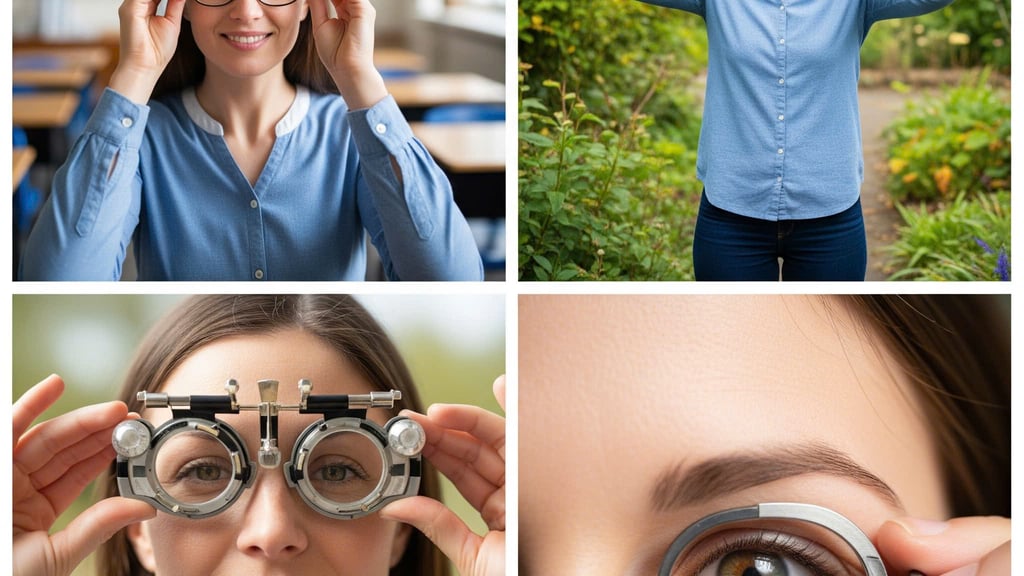A Schoolteacher's Journey to Natural Vision Improvement
3/29/20257 min read


Introduction to Natural Vision Improvement
Natural vision improvement refers to a range of methods and practices designed to enhance visual clarity without relying on conventional approaches such as glasses or surgical interventions. This holistic perspective on eye health emphasizes the potential of the human capacity for self-repair and improvement through various lifestyle changes, eye exercises, and relaxation techniques. Advocates of natural vision improvement believe that by adopting these strategies, individuals can alleviate vision-related issues and cultivate better overall eye health.
The philosophy behind these methods is rooted in the idea that a significant portion of eyesight deterioration is influenced by physical, emotional, and environmental factors. It is often suggested that modern lifestyles, including prolonged screen time, inadequate lighting, and poor posture, contribute to visual strain and discomfort. Rather than accepting these challenges as unavoidable, proponents of natural vision improvement encourage individuals to take a proactive role in maintaining and enhancing their vision.
Central to natural vision improvement are eye exercises that are thought to help strengthen the eye muscles and enhance focus. These exercises can range from simple techniques, such as focusing on distant objects or practicing eye rotations, to more structured programs that emphasize relaxation and mindfulness. Coupled with changes in daily habits, such as incorporating regular breaks from digital screens or adopting a nutrient-rich diet, these practices aim to rejuvenate visual clarity over time.
This approach aligns particularly well with the narrative of a schoolteacher who, motivated by personal experience and a desire for improvement, embarks on a journey to explore these methods. The drive to restore one’s natural vision can stem from a variety of frustrations related to conventional vision care. As the schoolteacher navigates the path of natural vision improvement, the anticipation of regaining clarity serves as both motivation and inspiration.
The Schoolteacher's Vision Struggles
As a dedicated schoolteacher, Sarah Thompson spends her days shaping young minds and fostering a love of learning in her classroom. However, her profession presents unique challenges, particularly regarding her vision. Over the years, Sarah has experienced increasing difficulties, including blurriness and eye strain, which have directly impacted her ability to teach effectively. As she stands at the front of her class, writing on the whiteboard or reading from lesson plans, the constant battle with her impaired eyesight has become all too familiar.
Throughout her career, Sarah has devoted herself to providing a nurturing and engaging environment for her students. Unfortunately, the vision problems she faces often hinder her teaching effectiveness. The blurriness can make it challenging to read printed materials or project visual aids clearly, leading to frustration for both her and her students. Observing confused faces rather than eager learners can be disheartening, emphasizing the urgency for a solution to her vision struggles.
Moreover, the strain caused by long hours of close reading and screen time has created a significant toll on her personal life. Sarah finds herself often fatigued by the end of the day, struggling with headaches and discomfort that make it difficult to engage fully with her family and friends. The emotional burden of not being able to perform at her best feels particularly heavy within the context of a profession that thrives on clarity and communication.
These vision issues not only affect Sarah's professional duties but also her interactions with students and colleagues. Feeling self-conscious about her impairments has, at times, led to a reluctance to engage in collaborative teaching strategies or classroom activities that require visual aids. This further emphasizes the critical need for natural vision improvement, as the prospect of reclaiming her sight would allow her to fully immerse herself in her teaching vocation.
Discovering Home-Based Techniques
Embarking on the journey toward natural vision improvement, the schoolteacher was initially met with skepticism regarding the effectiveness of home-based techniques. Living in an age dominated by technology and conventional solutions, the thought of improving vision through non-invasive, lifestyle adjustments seemed implausible. However, as the desire to enhance vision clarity grew stronger, curiosity began to eclipse doubts, prompting a thorough exploration of various methods available.
The search led to a wealth of online resources, ranging from informative articles to instructional videos dedicated to natural vision improvement. Additionally, the schoolteacher attended workshops that provided hands-on experience and insights into different techniques. These workshops not only focused on exercises but also emphasized the importance of nutrition for vision health, reinforcing the notion that what we consume significantly impacts our sight. Books authored by vision specialists provided a deeper understanding of the underlying principles, making the schoolteacher more inclined to experiment with the suggested methods.
Among the various techniques explored, eye relaxation exercises stood out as a pivotal component. These exercises, which promote eye muscle relaxation and reduce strain, were integrated into daily routines. Alongside these practices, an emphasis on proper nutrition emerged. The schoolteacher learned about vitamins and minerals essential for eye health, such as omega-3 fatty acids, lutein, and vitamins A, C, and E. This informative journey opened doors to mindfulness practices as well, revealing how mental clarity and reduced stress could positively affect vision.
This blend of both straightforward eye exercises and holistic living sparked newfound optimism in the schoolteacher, illustrating the possibility of substantial vision improvements without medical interventions. As each technique was tested, the schoolteacher’s skepticism gradually transformed into a proactive pursuit of better vision health, laying the groundwork for a transformative journey ahead.
Creating a Vision Improvement Routine
Establishing a structured routine for natural vision improvement can be vital for long-term success. The schoolteacher embarked on this journey by integrating specific exercises into their daily life, aiming to enhance clarity and overall visual function. It began with a well-defined schedule that allocated dedicated time slots for vision exercises, ensuring they became a regular part of the day.
To create this vision improvement routine, the teacher identified several exercises recommended in natural vision improvement literature. These included techniques such as palming, focusing exercises, and visualizations. Palming was practiced first thing in the morning to relax the eyes, while focusing exercises were strategically added to breaks between classes. The teacher made it a point to engage in visualizations during moments of downtime, such as during lunch breaks or before sleep, thereby maximizing the effectiveness of their routine.
Furthermore, the teacher recognized the need to adjust their teaching methodology to support this new regimen. For instance, they incorporated more visual-based learning activities in the classroom that not only benefited their students but also allowed the teacher to practice their vision exercises subtly while teaching. By being mindful of their environment, such as optimizing classroom lighting and reducing glare on screens, they not only improved their own visual comfort but also created a conducive learning environment for their students.
Consistency emerged as a crucial factor in this process. The teacher committed to their vision improvement routine daily, reflecting on their progress and making necessary adjustments. This unwavering commitment and structured approach proved essential in witnessing tangible improvement in their vision. Through careful planning and the incorporation of supportive teaching strategies, the schoolteacher took substantial steps towards achieving their goal of natural vision enhancement.
Tracking Progress and Overcoming Challenges
The journey toward natural vision improvement is profoundly impacted by the consistent tracking of one's progress. For the schoolteacher, maintaining a detailed record of visual enhancements became a crucial aspect of the process. Regularly using journals, they documented daily experiences, noting improvements and setbacks alike. By setting specific milestones, the teacher could clearly see advancements in vision clarity, helping to bolster motivation during challenging periods. These entries not only served as a reflection tool but also highlighted moments of success, making it easier to navigate the emotional landscape of their vision journey.
Incorporating vision charts into their routine provided an additional layer of tracking. The teacher used these charts to conduct visual acuity tests at regular intervals, which facilitated direct comparisons over time. Additionally, gathering informal feedback from colleagues and students proved invaluable. Observations from others often illuminated changes that the teacher might not have recognized themselves, reinforcing the tangible progress made through dedication to vision improvement practices.
Perseverance was paramount; setbacks were encountered, but they were viewed as learning opportunities. Staying focused on long-term goals helped to mitigate the impact of short-term challenges. Ultimately, this approach highlighted the significance of resilience in the journey toward achieving clearer vision naturally.
Experiencing the Benefits of Improved Vision
Improved vision can significantly enhance one’s quality of life, and the schoolteacher in this journey is no exception. After actively engaging in natural vision improvement techniques, the teacher experienced a remarkable regain in visual clarity. Activities that once blurred into unintelligible shapes transformed into vivid, detailed scenes. This rapid transformation not only rekindled the joy of seeing but also reignited a passion for teaching, leading to a more immersive learning experience for both the teacher and their students.
Alongside a renewed sense of visual clarity, the schoolteacher also noted a substantial reduction in eye strain. Teaching often requires extended periods of reading and direct focus on students, which can lead to discomfort. The new vision practices alleviated this strain, resulting in fewer headaches and improved comfort during long classroom hours. With eyes free from fatigue, the teacher could maintain optimal engagement levels throughout the day, contributing to a more dynamic and responsive educational environment.
Moreover, enhanced focus became a key benefit that permeated various aspects of the teacher's professional life. With clearer vision, attentiveness surged, allowing for improved interactions with students. The schoolteacher found that they could better assess student expressions and body language, fostering meaningful connections and supporting students' learning needs more effectively. This newfound clarity and focus extended beyond classroom interactions, resulting in greater collaboration with colleagues and enriched participation in school initiatives.
The tangible benefits experienced by the teacher in terms of improved visual clarity, reduced eye strain, and enhanced focus reflect a broader narrative of personal fulfillment. As the teacher navigates through each day with renewed vigor, the improved vision has contributed positively to their overall quality of life, allowing them to thrive both personally and professionally.
Conclusion and Future Commitment
Reflecting on my journey towards natural vision improvement, I am filled with a sense of gratitude for the transformation I have experienced. Embracing alternative methods for enhancing visual health has not only corrected my vision but also fostered a deeper understanding of eye care. Through dedicated practice and commitment, I have learned that adequate self-care and mindfulness can lead to significant benefits in maintaining optimal vision.
As I move forward, I recognize that this journey does not end here. The process of improving and preserving visual health requires ongoing effort and adaptation. I am dedicated to continuing my education about effective strategies for natural vision improvement and eye care. It is crucial to remain vigilant about the changes in my eyesight and to regularly reassess my visual habits. Incorporating exercises that strengthen eye muscles and researching new techniques ensures that I remain proactive in my approach to maintaining eye health.
Furthermore, I believe that sharing my experience can empower others facing similar challenges. Many individuals may feel discouraged about their vision, often resorting to traditional corrective measures without considering alternative methods. I encourage each reader to explore the various options available for natural vision improvement and to take ownership of their eye health. It is possible to embrace a proactive approach that promotes overall well-being and visual clarity.
In commitment to lifelong learning about vision care, I hope to inspire others to prioritize their eye health and seek out methods that resonate with them personally. Through community support and knowledge sharing, we can collectively foster an environment where everyone has access to the insights necessary for improving their vision naturally. Together, let us embark on this journey towards clarity and empowerment.
